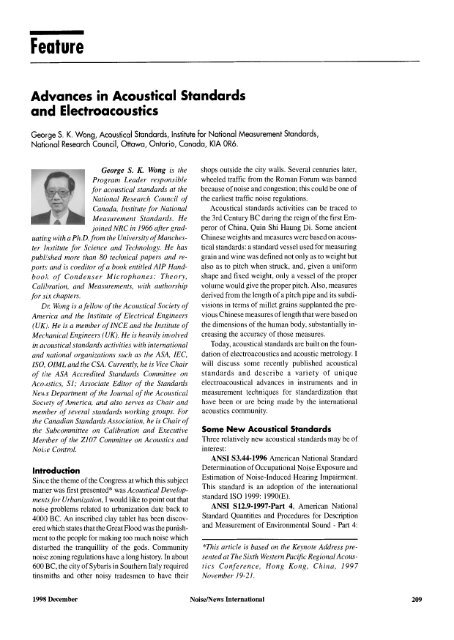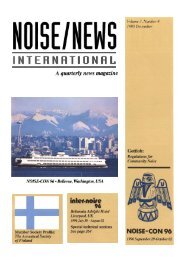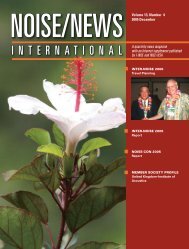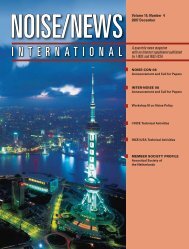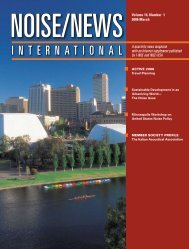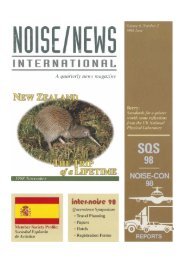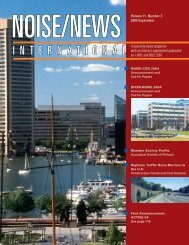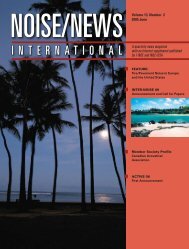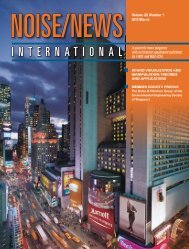Volume 6, Number 4, December, 1998 - Noise News International
Volume 6, Number 4, December, 1998 - Noise News International
Volume 6, Number 4, December, 1998 - Noise News International
You also want an ePaper? Increase the reach of your titles
YUMPU automatically turns print PDFs into web optimized ePapers that Google loves.
Feature<br />
Advances in Acoustical Standards<br />
and Electroacoustics<br />
Georqe S. K. Wong, Acoustical Standards, Institute For National Measurement Standards,<br />
National Research Council, Ottawa, Ontario, Canada, KIA OR6.<br />
George S. K. Wong is the<br />
Program Leader responsible<br />
for acoustical standards at the<br />
National Research Council of<br />
Canada, Institute for National<br />
Measurement Standards. He<br />
joined NRC in 1966 after graduating<br />
with a Ph.D. from the University ofManchester<br />
Institute for Science and Technology. He has<br />
published more than 80 technical papers and reports<br />
and is coeditor ofa book entitled AlP Handbook<br />
of Condenser Microphones: Theory,<br />
Calibration, and Measurements, with authorship<br />
for six chapters.<br />
Dr. Wong is a fellow ofthe Acoustical Society of<br />
America and the Institute of Electrical Engineers<br />
(UK,I. He is a member ofINCE and the Institute of<br />
Mechanical Engineers (UK). He is heavily involved<br />
in acoustical standards activities with international<br />
and national organizations such as the ASA, IEC,<br />
ISO, OIML and the CSA. Currently, he is Vice Chair<br />
of the ASA Accredited Standards Committee on<br />
Acoustics, 51; Associate Editor of the Standards<br />
<strong>News</strong> Department of the Journal ofthe Acoustical<br />
Society ofAmerica, and also serves as Chair and<br />
member of several standards working groups. For<br />
the Canadian Standards Association, he is Chair of<br />
the Subcommittee on Calibration and Executive<br />
Member of the ZI07 Committee on Acoustics and<br />
<strong>Noise</strong> Control.<br />
Introduction<br />
Since the theme ofthe Congress at which this subject<br />
matter was first presented* was Acoustical Developmentsfor<br />
Urbanization, I would like to point out that<br />
noise problems related to urbanization date back to<br />
4000 BC An inscribed clay tablet has been discovered<br />
which states that the Great Flood was the punishment<br />
to the people for making too much noise which<br />
disturbed the tranquillity of the gods. Community<br />
noise zoning regulations have a long history. In about<br />
600 BC, the city ofSybaris in Southern Italy required<br />
tinsmiths and other noisy tradesmen to have their<br />
shops outside the city walls. Several centuries later,<br />
wheeled traffic from the Roman Forum was banned<br />
because of noise and congestion; this could be one of<br />
the earliest traffic noise regulations.<br />
Acoustical standards activities can be traced to<br />
the 3rd Century BC during the reign ofthe first Emperor<br />
of China, Quin Shi Haung Di. Some ancient<br />
Chinese weights and measures were based on acoustical<br />
standards: a standard vessel used for measuring<br />
grain and wine was defined not only as to weight but<br />
also as to pitch when struck, and, given a uniform<br />
shape and fixed weight, only a vessel of the proper<br />
volume would give the proper pitch. Also, measures<br />
derived from the length of a pitch pipe and its subdivisions<br />
in terms of millet grains supplanted the previous<br />
Chinese measures oflength that were based on<br />
the dimensions of the human body, substantially increasing<br />
the accuracy of those measures.<br />
Today, acoustical standards are built on the foundation<br />
of electroacoustics and acoustic metrology. I<br />
will discuss some recently published acoustical<br />
standards and describe a variety of unique<br />
electroacoustical advances in instruments and in<br />
measurement techniques for standardization that<br />
have been or are being made by the international<br />
acoustics community.<br />
Some New Acoustical Standards<br />
Three relatively new acoustical standards may be of<br />
interest:<br />
ANSI S3.44·1996 American National Standard<br />
Determination ofOccupational <strong>Noise</strong> Exposure and<br />
Estimation of <strong>Noise</strong>-Induced Hearing Impairment.<br />
This standard is an adoption of the international<br />
standard ISO 1999: 1990(E).<br />
ANSI SI2.9-1997-Part 4, American National<br />
Standard Quantities and Procedures for Description<br />
and Measurement of Environmental Sound - Part 4:<br />
*This article is based on the Keynote Address presented<br />
at The Sixth Western Pacific Regional Acoustics<br />
Conference, Hong Kung, China, 1997<br />
November 19-21.<br />
<strong>1998</strong> <strong>December</strong><br />
<strong>Noise</strong>l<strong>News</strong> <strong>International</strong> 209


